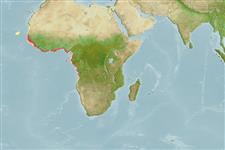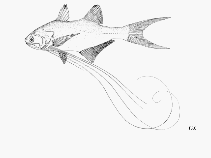Pentanemus quinquarius (Linnaeus, 1758)
Royal threadfin
Add your observation in Fish Watcher
| Native range | All suitable habitat | Point map | Year 2050 |

|
| This map was computer-generated and has not yet been reviewed. |
| Pentanemus quinquarius AquaMaps Data sources: GBIF OBIS |
Upload your photos and videos
Pictures | Google imagePentanemus quinquarius
Picture by FAO
Pictures | Google imagePentanemus quinquarius
Picture by FAO
Guinea country information
Common names:
Gbalakassa
Occurrence: native
Salinity: brackish
Abundance: | Ref:
Importance: minor commercial | Ref: FAO, 1994
Aquaculture: | Ref:
Regulations: | Ref:
Uses: no uses
Comments: Occurs in Fatala River (Ref. 28587). Reported from the Guinea shelf (Ref. 47102).
National Checklist:
Country Information: https://www.cia.gov/library/publications/resources/the-world-factbook/geos/gv.html
National Fisheries Authority: http://www.fis-net.com/guinea
Occurrences: Occurrences Point map
Main Ref: Daget, J. and J.C. Njock, 1986
National Database:
Occurrence: native
Salinity: brackish
Abundance: | Ref:
Importance: minor commercial | Ref: FAO, 1994
Aquaculture: | Ref:
Regulations: | Ref:
Uses: no uses
Comments: Occurs in Fatala River (Ref. 28587). Reported from the Guinea shelf (Ref. 47102).
National Checklist:
Country Information: https://www.cia.gov/library/publications/resources/the-world-factbook/geos/gv.html
National Fisheries Authority: http://www.fis-net.com/guinea
Occurrences: Occurrences Point map
Main Ref: Daget, J. and J.C. Njock, 1986
National Database:
Common names from other countries
Classification / Names Nomi Comuni | Sinonimi | Catalog of Fishes(Genere, Specie) | ITIS | CoL | WoRMS | Cloffa
> Carangaria/misc (Various families in series Carangaria) > Polynemidae (Threadfins)
Etymology: Pentanemus: Greek, pente = five + Greek, nema = filament (Ref. 45335).
More on author: Linnaeus.
Etymology: Pentanemus: Greek, pente = five + Greek, nema = filament (Ref. 45335).
More on author: Linnaeus.
Environment: milieu / climate zone / depth range / distribution range Ecologia
marino; salmastro demersale; distribuzione batimetrica 10 - 70 m (Ref. 10799). Tropical; 21°N - 18°S, 27°W - 14°E (Ref. 57343)
Distribuzione Stati | Aree FAO | Ecosystems | Presenze | Point map | Introduzioni | Faunafri
Eastern Atlantic: Senegal to Angola (Ref. 57402). Also reported from Mauritania (Ref. 10799) and Cape Verde (Ref. 27000). Reported from Cuba based on a single specimen; no other specimens taken from the western Atlantic (Ref. 57343).
Length at first maturity / Size / Peso / Age
Maturity: Lm 15.0 range ? - 17 cm
Max length : 35.0 cm TL maschio/sesso non determinato; (Ref. 57402); common length : 25.0 cm TL maschio/sesso non determinato; (Ref. 3659)
Max length : 35.0 cm TL maschio/sesso non determinato; (Ref. 57402); common length : 25.0 cm TL maschio/sesso non determinato; (Ref. 3659)
Short description Chiavi di identificazione | Morfologia | Morfometria
Spine dorsali (totale) : 9; Raggi dorsali molli (totale) : 14 - 18; Spine anali: 3; Raggi anali molli: 28 - 30. Diagnosis: detached pectoral filaments very long, exceeding body length; base of anal fin much longer than base of 2nd dorsal fin; body moderately elongate and compressed, its height comprised 3.0-3.4 in standard length; snout very short, blunt and prominent; mouth inferior; maxillary bone strongly widened at its end, reaching largely past eye; 2 widely separated dorsal fins, 1st with 8 flexible spines, 2nd with 1 spine and 14-18 soft rays; anal fin base much longer than 2nd dorsal fin base; pectoral fin inserted very low on body; threadlike filaments, 5 in number, 4 of them longer than total length of fish; scales ctenoid; head scaly (Ref. 57402).
Coloration: body uniformly silvery, greyish on back, shading to whitish ventrally; fins tinged with yellow (Ref. 57402).
Occurs over sandy (Ref. 2683) and muddy bottoms in shallow waters (Ref. 57343), frequently in brackish waters (Ref. 57343, 57402) and estuaries (Ref. 57402). Carnivorous (Ref. 57402), feeds on fish and shrimps (Ref. 28587).
Life cycle and mating behavior Maturità | Riproduzione | Deposizione | Uova | Fecundity | Larve
Main reference
Upload your references | Bibliografia | Coordinatore | Collaboratori
Motomura, H., 2004. Threadfins of the world (Family Polynemidae). An annotated and illustrated catalogue of polynemid species known to date. FAO Spec. Cat. Fish. Purp. Rome: FAO. 3:117 p. (Ref. 57343)
IUCN Red List Status (Ref. 130435: Version 2024-2)
Vulnerabile, vedi Lista Rossa IUCN (VU) (A2bd); Date assessed: 15 July 2014
Threat to humans
Harmless
Human uses
Pesca: elevato interesse commerciale
FAO(pesca: production; publication : search) | FishSource | Sea Around Us
Informazioni ulteriori
Population dynamics
Growth parameters
Max. ages / sizes
Length-weight rel.
Length-length rel.
Length-frequencies
Mass conversion
Reclutamento
Abbondanza
Growth parameters
Max. ages / sizes
Length-weight rel.
Length-length rel.
Length-frequencies
Mass conversion
Reclutamento
Abbondanza
Life cycle
Riproduzione
Maturità
Fecundity
Deposizione
Spawning aggregations
Uova
Egg development
Larve
Dinamica popolazioni larvali
Riproduzione
Maturità
Fecundity
Deposizione
Spawning aggregations
Uova
Egg development
Larve
Dinamica popolazioni larvali
Anatomy
Area branchiale
Brain
Otolith
Area branchiale
Brain
Otolith
Physiology
Body composition
Nutrients
Oxygen consumption
Swimming type
Swimming speed
Visual pigments
Fish sound
Diseases & Parasites
Toxicity (LC50s)
Body composition
Nutrients
Oxygen consumption
Swimming type
Swimming speed
Visual pigments
Fish sound
Diseases & Parasites
Toxicity (LC50s)
Genetics
Genetica
Heterozygosity
Ereditarietà
Genetica
Heterozygosity
Ereditarietà
Human related
Aquaculture systems
Profili di acquacoltura
Varietà
Ciguatera cases
Stamps, coins, misc.
Aquaculture systems
Profili di acquacoltura
Varietà
Ciguatera cases
Stamps, coins, misc.
Strumenti
E-book | Giuda pratica | Chiavi di identificazione | Generatore frequenze di lunghezza | Strumento Parametri Biologici | Mappa dei ritrovamenti | Classification Tree
| Catch-MSY |
Special reports
Download XML
Fonti Internet
Aquatic Commons | BHL | Cloffa | Websites from users | Check FishWatcher | CISTI | Catalog of Fishes(Genere, Specie) | DiscoverLife | ECOTOX | Faunafri | Fishtrace | GenBank(genome, nucleotide) | GloBI | GOBASE | | Google Books | Google Scholar | Google | IGFA World Record | MitoFish | Otolith Atlas of Taiwan Fishes | PubMed | Reef Life Survey | Scirus | SeaLifeBase | Tree of Life | Wikipedia(Go, ricerca) | World Records Freshwater Fishing | Zoological Record
Estimates based on models
Preferred temperature (Ref. 115969): 20.2 - 27.9, mean 25.8 (based on 70 cells).
Phylogenetic diversity index (Ref. 82804): PD50 = 1.0000 [Uniqueness, from 0.5 = low to 2.0 = high].
Bayesian length-weight: a=0.00398 (0.00236 - 0.00672), b=3.13 (2.99 - 3.27), in cm Total Length, based on LWR estimates for this species & (Sub)family-body (Ref. 93245).
Trophic level (Ref. 69278): 3.6 ±0.57 se; based on food items.
Resilienza (Ref. 120179): Alto, tempo minimo di raddoppiamento della popolazione meno di 15 mesi (K=0.72).
Fishing Vulnerability (Ref. 59153): Low to moderate vulnerability (31 of 100).
Climate Vulnerability (Ref. 125649): High to very high vulnerability (75 of 100).




